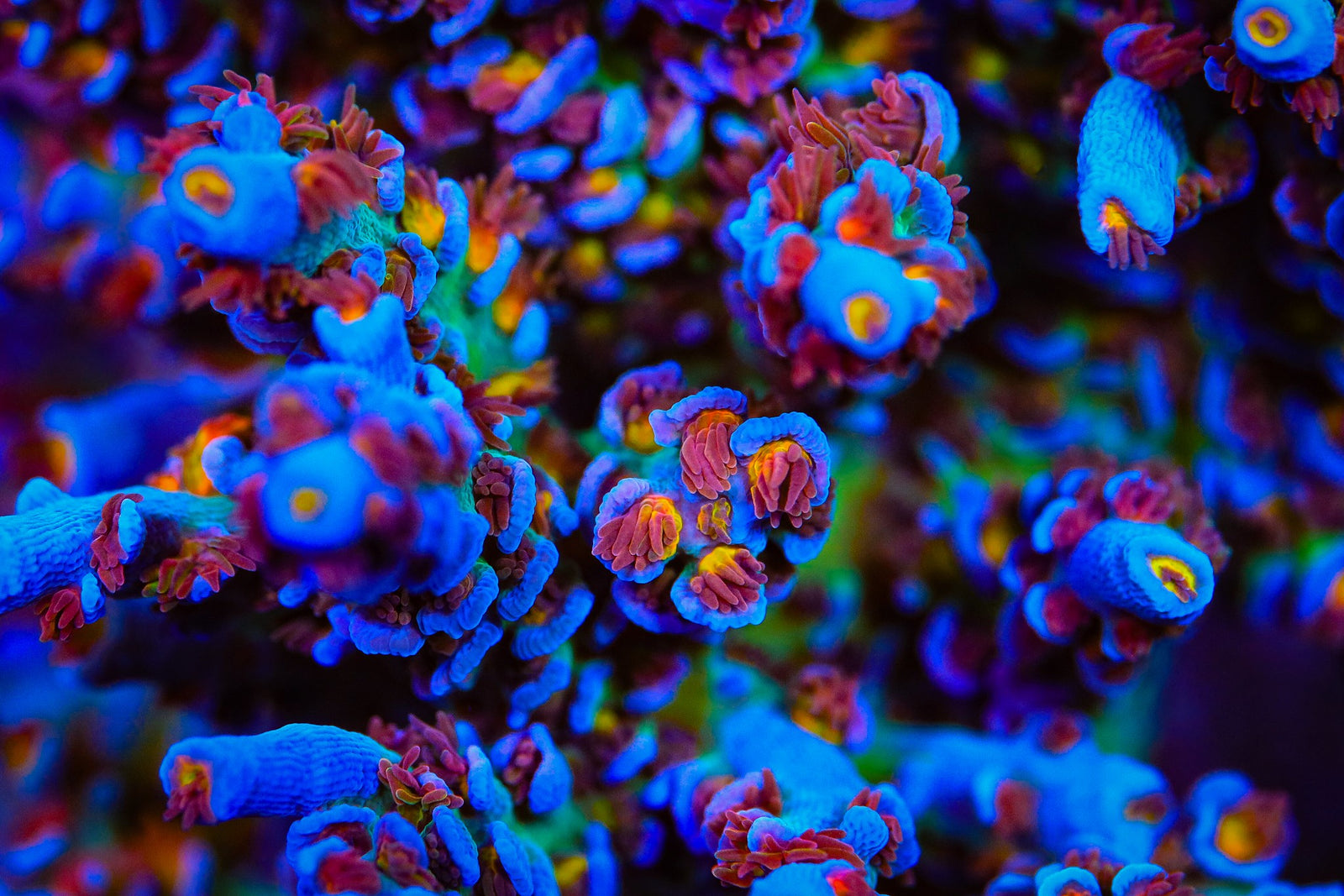Coral reefs are not only one of the most biodiverse ecosystems on Earth; they also rank among the most visually captivating. Achieving vibrant coloration in corals within aquariums merges the complexities of science with the finesse of artistry, captivating both hobbyists and professionals. The Secrets Behind Coral Coloration in Aquariums opens a window into the myriad factors that influence the vivid hues of corals under our care, with a spotlight on the innovative practices at Top Shelf Aquatics. Our mission is to champion the sustainable cultivation and propagation of exceptionally bright and vibrant corals, aiming to reduce the need for harvesting wild coral colonies and thus protect natural reef ecosystems.
At Top Shelf Aquatics, our path to achieving extraordinary coral coloration is paved with a commitment to excellence and sustainability. We utilize advanced Radion LEDs and metal halides capable of producing over 800 PAR, closely mimicking the natural light conditions under which corals flourish. Water quality is meticulously managed, with each tank's parameters finely tuned to meet the corals' specific needs. Nutrition is another cornerstone of coral health and coloration; we set a high standard by feeding a variety of live feeds, including phytoplankton, cultured in-house by our specialized lab, Reef Genetics. This facility not only produces high-quality phytoplankton but also engages in aquaculturing a diverse array of saltwater invertebrates, furthering our commitment to sustainability.
This article will navigate through the crucial factors affecting coral coloration, such as light, water quality, nutrition, and genetics, enriched by insights from our practices at Top Shelf Aquatics. Whether you are a seasoned aquarist or a newcomer eager to explore the world of coral care, the knowledge shared here will empower you to enhance the coloration and health of your coral collection, creating an enchanting underwater landscape in your aquarium.
Factors Influencing Coral Colors
Achieving vibrant and diverse coral coloration is a hallmark of success for any reef aquarium enthusiast. At Top Shelf Aquatics, our approach is rooted in a deep understanding of the environmental and biological factors that impact coral health and pigment expression. Here, we break down these factors into three primary categories: light, water quality, and nutrition.
Light: The Foundation of Color
The type and intensity of light corals are exposed to play a pivotal role in their coloration. Corals contain photosynthetic algae called zooxanthellae, which rely on light to produce nutrients for the coral. The specific spectrum and intensity of light can significantly influence the pigments corals develop. We employ Radion LEDs and metal halides capable of generating over 800 PAR (Photosynthetically Active Radiation), providing a broad spectrum of light that mimics natural sunlight conditions. This high PAR level is crucial for promoting the growth of vibrant, colorful corals, replicating the intense light conditions found in their natural reef habitats.
Water Quality: The Cornerstone of Coral Health
Maintaining pristine water quality is essential for the health and coloration of corals. Parameters such as temperature, pH, alkalinity, and nutrient levels must be carefully monitored and adjusted to create an optimal environment for corals to thrive. Each tank is constantly tested to ensure that these parameters are maintained within strict limits. This vigilant approach to water quality helps prevent stress on the corals, which can lead to color loss and inhibit growth.
Nutrition: Fueling Colorful Growth
Corals require a balanced diet to display their most vibrant colors. We provide our corals with a variety of live feeds, including phytoplankton cultured in-house by our lab, Reef Genetics. This tailored nutrition plan ensures that corals receive a mix of essential nutrients, vitamins, and minerals, promoting healthy growth and vivid coloration. The phytoplankton we culture is specifically selected for its nutritional value, providing a natural and effective food source for our corals.
Optimizing Conditions for Vibrant Coral Colors
Creating a vibrant display of coral colors in an aquarium is an achievable goal for aquarists at all levels of experience. By understanding and optimizing the conditions that corals thrive in, hobbyists can significantly enhance the coloration and health of their coral specimens. Here, we outline key strategies for optimizing lighting, water quality, and nutrition to support vibrant coral growth.
Optimal Lighting Conditions
Lighting is perhaps the most critical factor in promoting vibrant coral coloration. The goal is to mimic the natural light conditions of coral reefs as closely as possible. This involves:
- Choosing the Right Spectrum: A broad spectrum of light, particularly in the blue and ultraviolet ranges, can enhance the fluorescence and coloration of many coral species.
- Adjusting Intensity and Duration: The intensity of light should be adjusted based on the specific needs of the corals in your tank, with a careful balance to avoid bleaching. Similarly, the duration of lighting should replicate natural day-night cycles to support healthy coral metabolism.
Stable Water Parameters
For corals to thrive and exhibit their best colors, certain water parameters must be kept stable and within specific ranges:
- pH: The ideal pH range for coral growth is between 8.1 and 8.4. This range helps ensure that corals can efficiently absorb the carbonate ions needed for calcium carbonate production, essential for their skeletal growth.
- Alkalinity: Alkalinity should be maintained between 8 and 12 dKH (degrees of Carbonate Hardness). This parameter helps stabilize pH levels and is critical for coral health and growth.
- Calcium: Calcium levels should be kept between 380 and 450 ppm (parts per million). Calcium is vital for the skeletal development of stony corals.
- Magnesium: Magnesium levels should range from 1250 to 1350 ppm. Magnesium is essential for balancing the concentrations of calcium and alkalinity in the water.
- Salinity: The ideal salinity for a reef aquarium is between 1.023 and 1.025 specific gravity. Proper salinity levels are crucial for the osmoregulation of corals and other reef inhabitants.
Providing Adequate Nutrition
Nutrition plays a vital role in the health and coloration of corals. A balanced diet ensures corals receive the necessary nutrients to support vibrant colors:
- Varied Diet: Provide a mix of phytoplankton, zooplankton, and other coral foods to mimic the natural diet of corals. This variety ensures corals receive all the necessary nutrients and trace elements.
- Supplementation: Consider adding supplements that specifically target coral health and coloration. These can include amino acids, vitamins, and trace elements that support pigment production and overall coral vitality.
Avoiding excessive nutrients, such as nitrates and phosphates, is essential as they can lead to unwanted algae growth and diminish coral coloration. Implementing efficient filtration systems, performing regular water changes, and managing the bioload of the aquarium can help maintain nutrient levels within appropriate bounds.
Regular Monitoring and Adjustment
The key to optimizing conditions for coral coloration is regular monitoring and adjustment. Each aquarium is unique, and what works for one may not work for another. Regularly testing water parameters, observing coral health and coloration, and adjusting care routines accordingly can help identify the best practices for your specific setup.

